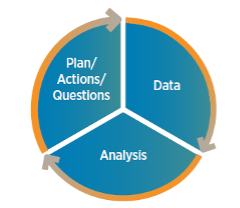Articles
Getting Your Data Right Requires FP&A
- By Bryan Lapidus, FPAC
- Published: 11/7/2022
.png?sfvrsn=7011126b_1)
It has been almost two decades since we were introduced to the phrase, “data is the new oil.” And while data permeates every facet of life and work, many of our AFP members tell us they still struggle to get their data right.
Others are making great progress, and the case studies in the AFP FP&A Guide: Get Your Data Right, underwritten by Workday, show how FP&A can be front and center in the work of data transformation. Four of the six case studies are from FP&A practitioners, a fifth is a consultant to FP&A, and the outlier is the CFO/COO! Why is that?
Andrew Codd, presenter of the “Data Changes Your People Strategy” case study, provides an analogy: “Imagine creating a paint-by-numbers picture with all the wrong data in the number-color- key. That’s what poor data is like. So why bother having an FP&A team if they cannot paint the picture of the company’s outlook? Management relies on FP&A’s outputs, which means they rely on their inputs.”
Quality data is central to FP&A
FP&A connects long-term strategy to current and anticipated operational activities by supporting decisions and allocating capital to its best use. The “data supply chain” for FP&A demands reliable, accessible data to deliver FP&A services:
-
Planning: FP&A incorporates both business and operational drivers into the budget and forecasting processes. Timely, accessible, quality data drives the ability to receive and incorporate actuals, reforecast continuously, deploy rolling forecasts, have multiple plans, and deliver assessments.
-
Performance management: FP&A supports the design and deployment of appropriate metrics to hold the business and individuals accountable; the management reporting process should deliver the right information to the right person at the right time in the right format. Automated calculation, collection and dissemination allow everyone to get to work faster with the latest information.
-
Financial analysis: FP&A applies financial expertise and business understanding through modeling, pro-formas and analysis. Data is the input, and the data management tools can elevate the team’s performance, including ease of variance analyses, trending and correlation analytics, exception reporting, machine learning applications for forecasting, and creating a recommendation engine for actions.
-
Current efficiency and future development of FP&A: Several studies indicate that FP&A spends half to three-quarters of its time wrangling data and managing data processes, leading to a multitude of challenges, such as manual work, inefficient processes, errors, high system costs, missed opportunities for the business and frustration for those who work the process. Poor data also precludes all the exciting, buzzy technologies on the horizon, such as artificial intelligence, machine learning, predictive analytics and prescriptive analytics.
In all of these efforts, data and supporting data management tools help FP&A and the business increase the velocity of business decisions by getting around the wheel of plan/question to data to analysis and back to plan/question/action. “A business cannot function without clear and concise reporting of its current and expected financial position. To get this wrong is to run the company blindly,” says Greg Gillespie, the presenter of “Create a Center of Excellence Around Reporting.”

FP&A is central to quality data
At the same time, FP&A is well situated to lead these types of transformative efforts for several reasons:
-
Performing this function already: To a degree, finance and FP&A are already doing a portion of this work through financial and management reporting.
-
Connected: By design, FP&A has contacts and relationships with all parts of the organization to complete its work. “FP&A sits in a critical position at the nerve center of the organization, with an enterprise-wide view of the diverse stakeholders’ perspectives and the many critical business cycle decision points,” says Jesse Todd, presenter of the “Delivering Data as a Service” case study. “This gives FP&A a unique understanding of what data are needed and what relationships need to exist within the data in order to understand business performance and help lead the organization in making critical data-informed decisions. Sitting at the center of the organization’s nervous system gives FP&A a natural leadership role in driving data transformation.”
-
Objective: Several presenters spoke of finance as a neutral party during various negotiations, able to rise above individual business unit needs and quarterly sales goals, vanity metrics and favored projects. As part of the CFO organization, there is already expertise in managing sensitive data that crosses divisional silos to serve the best interest of executives, the board, investors and regulators.
-
Partnering: FP&A is accustomed to working in matrixed teams, and a theme throughout this document is that successful transformations require broad support, defined roles and business partnership.
“Finance, and FP&A in particular, is uniquely positioned to support leadership; they have the business acumen to understand what information members of a company’s leadership team need to make good decisions,” says Betsy Maclean, moderator of the “Data Changes Your People Strategy” case study. “Taken together this affords Finance the opportunity to function as the missing link that can bridge the chasm many companies have between reams of data and meaningful, insightful, actionable analysis.”
Are you ready to get your data right? Check out the AFP FP&A Guide: Get Your Data Right to learn more.
Copyright © 2024 Association for Financial Professionals, Inc.
All rights reserved.

